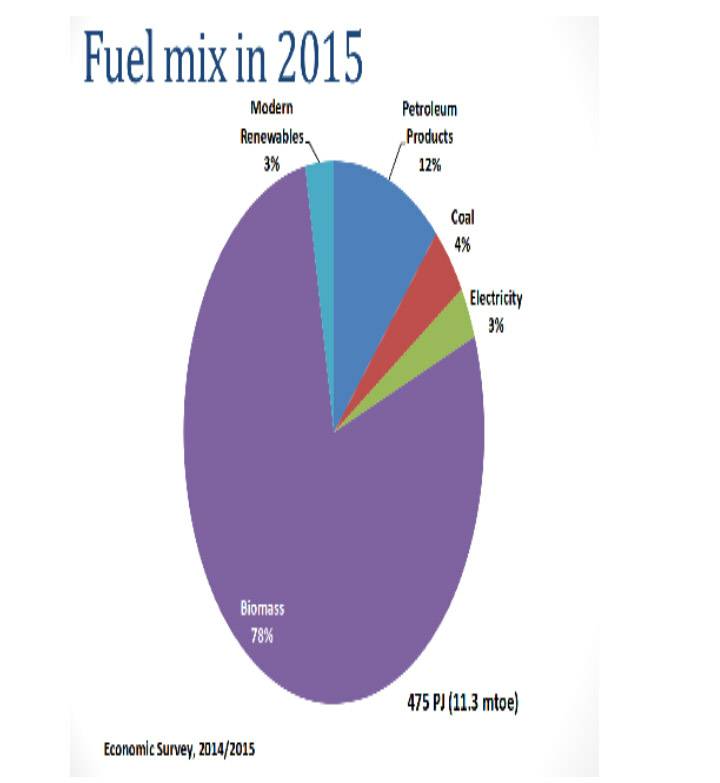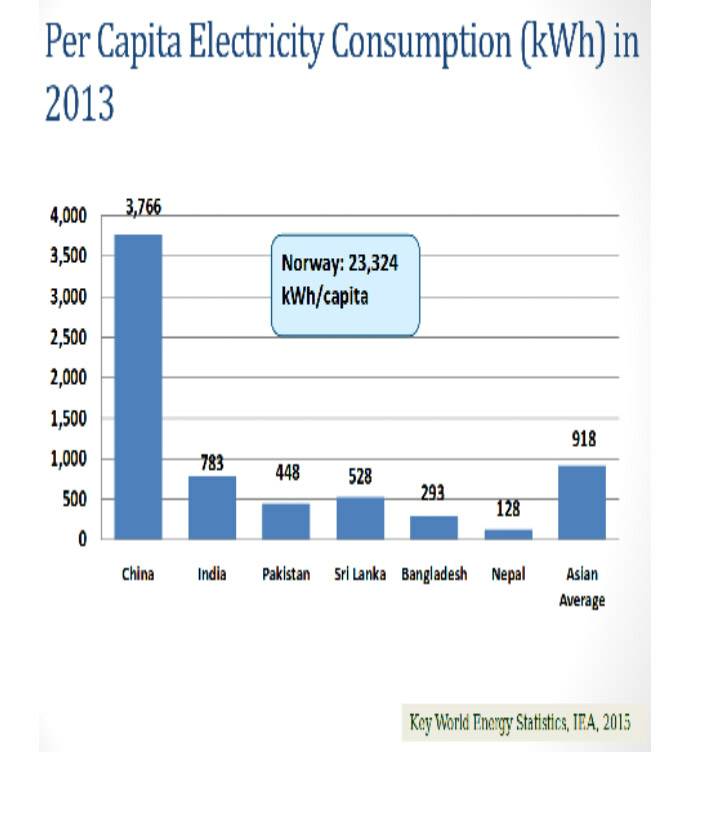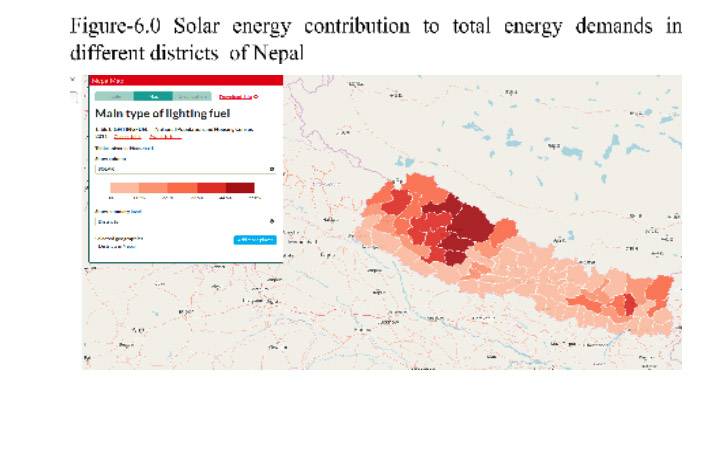SOLAR ENERGY- FUTURE OF HUMANITY AND KEY TO NEPAL’S PROSPERITY

- Gyaneshwar Agrahari
From the beginning of our civilization, the sun has been the center of attraction among all the observable cosmological bodies. The simple reason behind our curiosity about the sun is that it is the shiniest object in our sky. In a period of many centuries, from Copernican heliocentrism to Keppler’s planetary motion postulates and from Newton’s law of gravitation to general theory of relativity, our knowledge about sun and its motion became better and more accurate. Advancement of high resolution telescopes enabled us to observe different phenomena occurring on sun’s surface; Nuclear Physics guided us to know how energy is produced in its core; nevertheless, in my point of view, quantum theory of light brought a revolutionary change in our thinking about the sun. Before this theory, we just considered the sun as a source of heat and light which it gives us in the form of electromagnetic radiations, but this theory made us realize “No!, the sun is much more than being a prerequisite for life to sustain on our planet; it is an ultimate source for all kinds of energy.” According to the quantum theory, light ,we get from the sun, is quantized; it comes in small packets of energy called photons. Photons can excite an electron to a higher energy level and those excited electrons can be knocked out of the atomic lattice if provided sufficient amount of energy. This phenomena became the fundamental of a new kind of source of energy- Solar energy.
From the day the current electricity have been invented, its applications in every sector of the society have increased at tremendous rates. We have been doing a lot of research on just making the turbines move so that electricity is produced. We have tried everything we have around – coal (thermal) , rivers (hydroelectricity), hot springs( geothermal energy), sea (tidal energy), and radioactive elements (nuclear energy)- to produce electricity but none of them produces electric current directly like solar panels. Basically, solar panels are the clusters of photovoltaic cells. Different kinds of phtotvoltaic cells( PV Cells) – mono-crystalline and poly-crystalline silicon(first generation solar cells); Thin film based (second generation solar cells); organic , quantum dots, and perovskite (third generation solar cells) – are available at present. Photovoltaic cells have different layers of n-type and p-type semiconductors. Photons having equal or higher energy than the band gap maintained between the layers of semiconductors excite the electrons in the valence band to conduction band creating electron-hole pairs. Because of forward biasing, the majority charges (electrons in in the n- type semiconductors and holes in p-type semiconductors) flow vigorously producing direct electric current between the electrodes. The inverter is used to convert the direct current into alternating current. The simple demonstration of forward biasing is shown in figure-1.0.
At the beginning of the 21st century, scientists had started to apprehend that the sources of energy we were using would be insufficient to accomplish the goals of the future: the goal to make the world coal and petroleum free, the goal to protect our earth and its biodiversity from global warming, and the goal to provide energy to everyone at affordable prices. An alternative of those sources was required to achieve these objectives and thus the market of solar panels started to incline exponentially. By the end of 2016, we had already had installed solar panels with a total capacity of 303 gigawatts. Because of the substantial investment in solar panels manufacturing, the price per watt for solar panels has decreased significantly. Today, the cost of solar power is approximately 0.25 dollars per watt.
Figure 2.0![]()
Though, solar energy contributed only 1.3 percent of the global energy demand in 2016, it received the highest growth among all the energy resources. The figure 3.0 clearly implies that the world is looking forward to increase solar energy output in coming years. We have generally two distinctive ways to effectuate the target – financial and scientific. The first one is about promoting capital in solar energy. The present governments of many nations are providing subsidies as well as focusing on policies that encourage private sector to invest in solar energy. Easing the land acquisition for solar fields, promoting rooftop solar panels at local level, and sanctioning loans at lower interest rates are the part of economic prospect of fostering solar energy.
The other mechanism is to increase the efficiency of the solar panels so that we can get more yield consuming less number of solar panels and area of land, and reducing the labor demand and the cost of maintenance. Today, first generation solar cells are dominating the market of solar cells especially the poly-crystalline cells due to its cheaper rates, but it has only 13% efficiency in average. The scientists today are making efforts to produce third generation solar cells with efficiency above 40%. The problem with silicon solar cells is that is has only one and fixed band gap( energy gap between two layers of silicon); therefore, photons of only one wavelength excite the electrons and more than a half of the power of the light is wasted as heat. This heat also leads to extra wastage through black body radiation. In, multi-junction solar cells, multiple band gaps are available such that negligible portion of the incident light is wasted. Other different methods to increase solar panel efficiency are radiative cooling, anti-reflective coating, use of hydrophobic layer to protect them from dust, and minimizing shading of solar panels. Advance researches are going on around the world to make the third generation solar cells cheaper and more efficient in producing energy than their conventional counterparts.
Let’s come to the second topic of the discussion- Nepal’s prosperity. Everyone is familiar with the fact that Nepal’s progress has not been able to complement Nepal’s potential. The biggest reason I can say is inability of our country to explore its resources and promote science and technology. If the amount of money we expend on importing goods every year is invested on substituting the old-fashioned methods we are still using in manufacturing, energy and agriculture with advance techniques and machinery, we won’t need to wait for decades to see our country having a trade surplus rather than a trade deficit of billions of rupees as seen in the present circumstances.
Talking about the current scientific energy production in Nepal, I can only think about the hydro power. From primary school, we are habituated to discuss about the number “83,000 MW” capacity of hydroelectricity which in reality is nothing more than a rumor. Neither the government nor people of Nepal actually ever focused on the fact that Nepal is located in a subtropical region as well as on a high altitude, and it receives average radiation of 4.7Kwh per square metre per day. A large hydroelectricity can make us reach few hundreds of megawatts of electricity, but provided that we are able to set up large solar fields with high-efficient solar panels and connect them to national grid ( high-voltage electricity connection of a nation), we can produce energy in gigawatts. According to Dr. Govinda Raj Pokhrel (ex-Executive Director of Alternative Energy Promotion Center(AEPC)), we can produce 2920 Gwh of energy per year just by using 0.01% land of Nepal for solar panels. Employing the costless power of the sun through solar panels, we also can get rid of the possible adverse effects of hydro power – degradation of aquatic ecosystem, increase in probability of catastrophic events like soil erosion and flood, emission of carbon dioxide and methane, and displacement of hundreds of people. Moreover, installation of rooftop solar panels can play a critical role in promotion of small-scale industries in rural areas of Nepal.
The government with overhyped proudness recently declared Nepal a “load shedding” free country,” but I am acutely unsatisfied with this announcement . The contention of the government officials that we are not facing a power cut because we are producing huge amount of energy is unquestionably false; the factual thing is we don’t have enough assets to have a big demand of energy. Still, around 60% of Nepalese households are dependent on forest wood and dung for cooking. In 2016, Nepal imported petroleum products worth 566 million US dollars for running transportation. Lighting a bulb at home and moving an fan can not be called absolute electrification. Our country will be a electrified country when it will be a gasoline and smoke free country which will only happen when every industry, every vehicle and every house in Nepal will completely operate on green electricity.
The figure 4.0 clearly shows that about Nepal is heavily dependent on conventional resources, whereas figure 5.0 demonstrates that we consume very less amount of energy in comparison to other countries in Asia. This is a proof that our industrial, agriculture and business sectors are still in inferior stage. The same survey says that 80% of energy in Nepal is consumed by households which again authenticate the very conclusion.
Figure-4
Figure-5

Now, the question arises that whether solar energy can change the current picture of energy in Nepal or not. The answer is a big “Yes.” The success of projects like National Rural and Renewable Energy Program (NRREP) and Karnali Ujyalo are the proofs of my argument. These projects not only made thousands of people in rural areas of Nepal self-dependent in energy but also had an positive impact on their socioeconomic lives providing them the basic infrastructures to expand their occupations.
The figure-6.0 undoubtedly showcases that the rural districts are ranked at the top among all the districts in solar energy contribution to the total energy demand of a district. This is the achievement of the projects mentioned above. There is still a big space of extension in the field of solar energy in Nepal. We have to walk on the path on which our our neighboring countries – India and China, which were on first and seventh position respectively in 2016 on the basis of capacity of their solar power output – have been walking. In 2015, Nepal and the World Bank signed an agreement to invest 130 million USD to develop a 25 MW solar project in Nuwakot district that will eventually be connected to the national grid. It is the largest renewable energy plant planned in the country. Many projects like this are needed to be initiated in Nepal in coming years.

Recently, Nepal Electricity Association came with an brilliant idea: to buy the surplus electricity produced by solar panels of households and commercial sector and add them to the national grid. Because very few of them produce solar energy equal to their necessity or even less, this project has not been as fruitful as it was expected at the beginning. This shows that it is not true we do not have creative ideas like people of developed countries. We just lack the policy, technology and mindset to implement them. In our nation, people still have a thought process that science and technology is a stuff for extremely educated and trained personnel. We need to soon realize that the revolution in energy through solar power is only possible when the private sector and the educational institutions coordinate with the government. As per my observations, education sector in Nepal is utterly passive when it comes to subscribing to nation’s prosperity. In contrary, the universities and colleges of developed countries energetically assist their governments by researching on new outlooks of science, innovating new technologies, and helping their governments in policy making on the basis of the conclusions of their studies. Universities of Nepal also have to play a critical role in guiding government institutions like AEPC (Alternative Energy Promotion Center) to foster solar energy in Nepal along with the alignment of international agencies like UNDP, World bank, and ADB.
Overall, a common inference that comes up with all the statistics, quotes, and logical reasonings presented above is: Solar energy is our future because it is associated to quantum mechanics which is the most exhilarating field of modern science having the greatest probability of discovering new things. Nepal also have to flow with the current of this modern science to find itself as a playmaker in place of just a spectator in the game of development.

